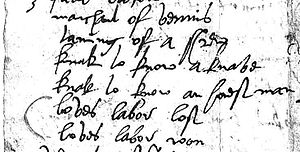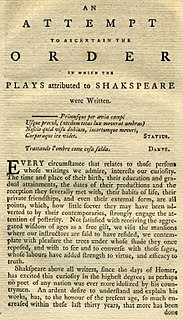
Christopher Hunt (fl. 1584-1607) was an Exeter bookseller and stationer.

Christopher Hunt (fl. 1584-1607) was an Exeter bookseller and stationer.
He was the son of Walter Hunt, a cordwainer of Blandford in Dorset. On 12 January 1585 he apprenticed himself to Thomas Man, a London stationer for a period of eight years, beginning the previous Christmas Day. He was admitted to the Stationer's Company as a freeman on 2 October 1592, and returned to Exeter and made a freeman in 1593. There he opened a stationery in the parish of St. Martin, selling books and other items such as writing supplies, and had two titles printed for him in London by Adam Islip, both of them translations by the Cornish translator and antiquary Richard Carew. He removed to London some time before May 1606 and located a shop in Paternoster Row. [1]
His wife's name is unknown. He had at least two children, Anne, baptised 24 March 1599 at St Martin's Church, and a son, Thomas, baptised 16 January 1602 in the same church, also a stationer.
Godfrey of Bvlloigne, or the Recouerie of Hiervsalem.An Heroicall Poeme, written in Italian by Seig. Torquato Tasso, and translated into English by R(ichard) C(arew], Esquire; and now the first part, containing fiue Cantos, Imprinted in both Languages. London, Imprinted by Iohn Windet for Christopher Hunt, of Exceter, 1594. (Quarto, 235 pages)
Examen de Ingenios. The Examination of Mens Wits.In which, by discouering the varietie of Natures, is shewed for what Profession each one is apt, and how far he shall profit therein. By John Huarte. Translated out of the Spanish Tongue by M. Camillo Camilli. Englished out of his Italian by R [ichard] C [arew], Esquire. London, Printed by Adam Islip for Christopher Hunt, at Exeter, 1594. (Quarto, 333 pages and a Table.)
The Parricide Papist, or Cut-throate Catholicke. "A tragicall discourse of a murther lately committed at Padstow in the Countie of Cornewall by a professed Papist, killing his owne Father, and afterwardes himselfe, in zeal of his Popish Religion. The 11 of March last past. 1606. Written by G. Closse, Preacher of the Word of God at Blacke Torrington in Devon. Printed at London for Christopher Hunt, dwelling in Pater-noster-row, neare the Kings-head. [1607]." (Quarto, 12 leaves.)
Hunt also had a patent granted by King James I to print a book titled Householders practise.
In 1954 fragments of Hunt's daybook at Blandford Fair in Dorset were found in the binding of a book of sermons published in 1637, one dated August 1603 and the other September 1607. On the verso of the 1603 sheet a list of 16 "[inter]ludes and tragedyes" sold from 9 to 17 August 1603 was found. The list included four of Shakespeare's plays, Merchant of Venice, The Taming of a Shrew, Love's Labour's Lost, and Love's Labour's Won, a play that had been mentioned by Francis Meres in his Palladis Tamia , (1598) but for which no other evidence had been found. The find provided evidence that the play was in fact a unique work that had been published but lost and not an early title of some other Shakespeare play. [2] Currently, this inventory list resides in The Rare Book & Manuscript Library at the University of Illinois at Urbana-Champaign.

The earliest texts of William Shakespeare's works were published during the 16th and 17th centuries in quarto or folio format. Folios are large, tall volumes; quartos are smaller, roughly half the size. The publications of the latter are usually abbreviated to Q1, Q2, etc., where the letter stands for "quarto" and the number for the first, second, or third edition published.

King Leir is an anonymous Elizabethan play about the life of the ancient Brythonic king Leir of Britain. It was published in 1605 but was entered into the Stationers' Register on 15 May 1594. The play has attracted critical attention principally for its relationship with King Lear, Shakespeare's version of the same story.

This article presents a possible chronological listing of the composition of the plays of William Shakespeare.

Love's Labour's Won is a lost play attributed by contemporaries to William Shakespeare, written before 1598 and published by 1603, though no copies are known to have survived. Scholars dispute whether it is a true lost work, possibly a sequel to Love's Labour's Lost, or an alternative title to a known Shakespeare play.

Thomas Thorpe was an English publisher, most famous for publishing Shakespeare's sonnets and several works by Christopher Marlowe and Ben Jonson. His publication of the sonnets has long been controversial. Nineteenth-century critics thought that he might have published the poems without Shakespeare's consent; Sidney Lee called him "predatory and irresponsible." Conversely, modern scholars Wells and Taylor assert their verdict that "Thorpe was a reputable publisher, and there is nothing intrinsically irregular about his publication."
William Jaggard was an Elizabethan and Jacobean printer and publisher, best known for his connection with the texts of William Shakespeare, most notably the First Folio of Shakespeare's plays. Jaggard's shop was "at the sign of the Half-Eagle and Key in Barbican."
Valentine Simmes was an Elizabethan era and Jacobean era printer; he did business in London, "on Adling Hill near Bainard's Castle at the sign of the White Swan." Simmes has a reputation as one of the better printers of his generation, and was responsible for several quartos of Shakespeare's plays. [See: Early texts of Shakespeare's works.]
Thomas Creede was a printer of the Elizabethan and Jacobean eras, rated as "one of the best of his time." Based in London, he conducted his business under the sign of the Catherine Wheel in Thames Street from 1593 to 1600, and under the sign of the Eagle and Child in the Old Exchange from 1600 to 1617. Creede is best known for printing editions of works in English Renaissance drama, especially for ten editions of six Shakespearean plays and three works in the Shakespeare Apocrypha.
Peter Short was an English printer based in London in the later Elizabethan era. He printed several first editions and early texts of Shakespeare's works.
Thomas Millington was a London publisher of the Elizabethan era, who published first editions of three Shakespearean plays. He has been called a "stationer of dubious reputation" who was connected with some of the "bad quartos" and questionable texts of Shakespearean bibliography.
George Eld was a London printer of the Jacobean era, who produced important works of English Renaissance drama and literature, including key texts by William Shakespeare, Ben Jonson, Christopher Marlowe, and Thomas Middleton.
Nathaniel Butter was a London publisher of the early 17th century. The publisher of the first edition of Shakespeare's King Lear in 1608, he has also been regarded as one of the first publishers of a newspaper in English.
Nicholas Okes was an English printer in London of the Jacobean and Caroline eras, remembered for printing works of English Renaissance drama. He was responsible for early editions of works by many of the playwrights of the period, including William Shakespeare, Ben Jonson, John Webster, Thomas Middleton, Thomas Dekker, Thomas Heywood, James Shirley, and John Ford.
Edward Allde was an English printer in London during the Elizabethan and Jacobean eras. He was responsible for a number of significant texts in English Renaissance drama, including some of the early editions of plays by William Shakespeare.

The True Tragedy of Richard III is an anonymous Elizabethan history play on the subject of Richard III of England. It has attracted the attention of scholars of English Renaissance drama principally for the question of its relationship with William Shakespeare's Richard III.

Q1 of Hamlet is a short early text of the Shakespearean play. The intended publication of the play is entered in the Stationers' Register in 1602 by James Roberts, but Q1 was not published until summer or autumn 1603. It was published by the booksellers Nicholas Ling and John Trundell, and printed by Valentine Simmes. Roberts later printed the "Second Quarto" (Q2).
James Roberts, was an English printer who printed many important works of Elizabethan literature. F. G. Fleay says that "he seems to have been given to piracy and invasion of copyright".

Nicholas Ling (fl.1570–1607) was a London publisher, bookseller, and editor who published several important Elizabethan works, including the first and second quartos of Shakespeare's Hamlet.
Edward White was a London printer and stationer whose career spanned a period of over forty years. His shop in the booksellers' district of St Paul's Churchyard was at the Sign of the Gun, where he sold many anonymous works as well as works by Thomas Kyd, Robert Greene, Anthony Munday and Christopher Marlowe. Between 1594 and 1611 he sold all three quartos of William Shakespeare's Titus Andronicus.
Edward Sharpham was an English playwright and pamphleteer.